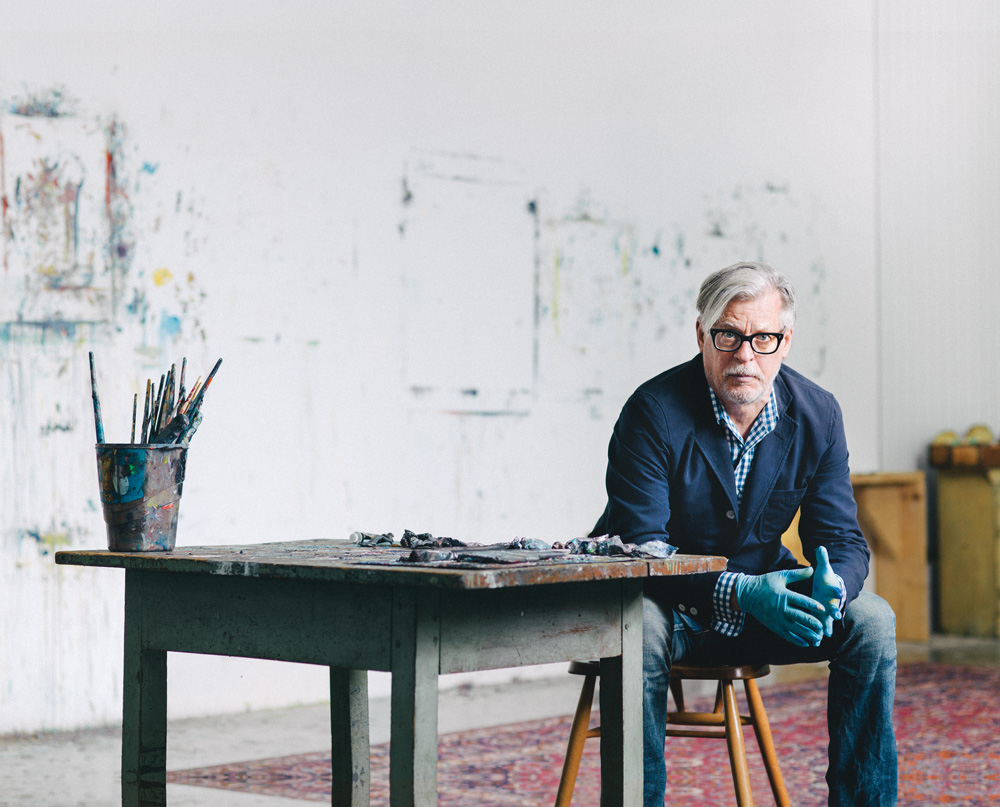For our 30th anniversary, Canadian Art presents a slideshow of portraits of some of the artists and art professionals who have shaped and continue to shape the Canadian art world.
Rodney Graham
With Jeff Wall, Ian Wallace, Stan Douglas and Ken Lum, Rodney Graham put Vancouver on the international art map with smart, conceptually based art that rode the wave of contemporary art’s adoption of photography. Who could forget Graham’s upside-down trees that became an icon of that moment? The upside-down image was something of an in-joke—that’s how a tree looks in the viewfinder of a large-format camera—and the sly sense of humour it suggested blossomed into a career’s worth of equally sly self-portrait images that continue to position Graham in a high-profile international practice that turns on wry stories of artists and their imaginations.
Rebecca Belmore
For a recent major group exhibition in Quebec City, Rebecca Belmore’s “artist statement” was simply not to provide one, leaving her work, and her refusal, to speak for itself. That defiant spirit toward art-world expectations, the institutional status quo and, most of all, the marginalized traumas of women and First Nations peoples has been a constant force behind Belmore’s hard-hitting performances and installations. In those, including at the Canada Pavilion for the 2005 Venice Biennale, the artist’s body is a supercharged site for individual and collective resistance. Belmore’s practice remains as uncompromisingly radical as it is inspirational.
Pierre Dorion
Working in an empty 11th-floor apartment overlooking Montreal’s Parc La Fontaine, painter Pierre Dorion created a masterwork of installation art with Chambres avec vues in 1999. On the walls were a suite of cool, precisely rendered paintings that read like mementos of an intimate, reflective urban life suddenly ended. The source images were various: a rooftop panorama in Europe, a view up to ceiling lights, an unmade bed…but in Dorion’s hands they became a memorial to the losses accruing from AIDS and a harbinger of the returning relevance of painting in the contemporary scene, where it proved itself, once again, to be an unparalleled recorder of history.
Garry Neill Kennedy
The artist and the legend: it’s not easy to separate the two when it comes to Garry Neill Kennedy. Since arriving in Halifax in 1967 as president of the then-parochial Nova Scotia College of Art, Kennedy has reigned as the figurehead of conceptual art in Canada. His 23-year tenure at the school, captured in his 2012 book The Last Art College, made NSCAD an international hub for idea-based teaching and artmaking. It’s a legacy mirrored in Kennedy’s art practice. A new teaching post at the University of British Columbia—and his signature large-scale wall works, infused with a politically critical agenda—are set to keep Kennedy on the leading and legendary edge.
Wayne Baerwaldt
Wayne Baerwaldt has curated an international reputation for Canada, making room for prairie artists in a scene that has tended to elide them. His achievements fall on either side of his triumphant selection of Janet Cardiff and George Bures Miller for the 2001 Venice Biennale, where they won two top prizes. As director of Winnipeg’s Plug In in the late 1990s, Baerwaldt helped shape what we now take for granted as “the Winnipeg scene.” Then, at Toronto’s Power Plant, he initiated shows by Glenn Ligon, the Royal Art Lodge and others. Now director and curator at the Alberta College of Art and Design’s Illingworth Kerr Gallery, his ambitions remain borderless.
Marc Mayer
It often seems as if Marc Mayer has been everywhere in the name of contemporary art. The current director of the National Gallery of Canada began in 1986 at the 49th Parallel Centre for Contemporary Canadian Art in New York—an important venue for Canadians amid that city’s then-hot SoHo scene. Subsequently, he has been pivotal in shaping institutional visions and directions, with high-profile roles at the Power Plant in Toronto, the Brooklyn Museum and the Musée d’art contemporain de Montréal. Since his 2008 appointment at the National Gallery, Mayer has seen his share of controversy and acclaim—his calling card a brash, refreshing form of cultural advocacy.
Barbara Fischer
Working from her base at the University of Toronto, Barbara Fischer, like Philip Monk of the Art Gallery of York University, has demonstrated the importance of university galleries for bringing topical relevance and a cool eye for cultural legacy to an art scene crowded with more populist museum programming. An early advocate of politicized art practices, multicultural and gender-based engagements with identity, Fischer has also made defining exhibitions about photo-based installation art (“Projections” in 2007) and Canadian conceptual art (“Traffic” in 2010). Combined, her exhibitions are a running history of the major movements in today’s art.
This is an article from the Fall 2014 issue of Canadian Art. To read more from this issue, visit its table of contents.









